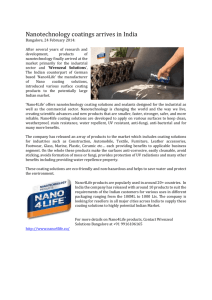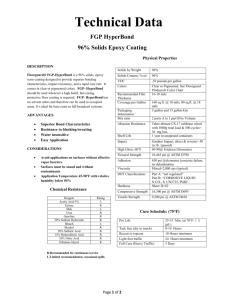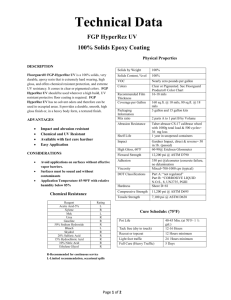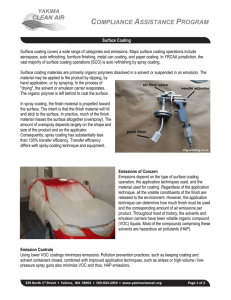COMPONENT COATING TO MINIMIZE RAW MATERIAL USAGE
advertisement
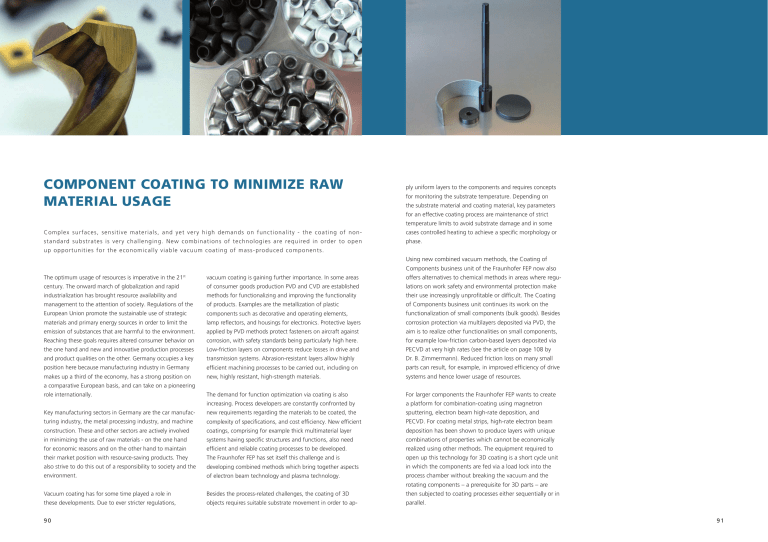
COMPONENT COATING TO MINIMIZE RAW MATERIAL USAGE ply uniform layers to the components and requires concepts for monitoring the substrate temperature. Depending on the substrate material and coating material, key parameters for an effective coating process are maintenance of strict temperature limits to avoid substrate damage and in some C om ple x sur f a c e s , s e n s i ti v e m a te ri a l s , and y et v ery hi gh demands on func ti onal i ty - the c oati n g of non- cases controlled heating to achieve a specific morphology or st a nda rd subs tra te s i s v e ry c h a l l e n g i n g . N ew c ombi nati ons of tec hnol ogi es are requi red i n order t o open phase. up oppor t uni ti e s fo r th e e co n o mi ca l l y v i abl e v ac uum c oati ng of mas s -produc ed c omponents . Using new combined vacuum methods, the Coating of Components business unit of the Fraunhofer FEP now also The optimum usage of resources is imperative in the 21st vacuum coating is gaining further importance. In some areas offers alternatives to chemical methods in areas where regu- century. The onward march of globalization and rapid of consumer goods production PVD and CVD are established lations on work safety and environmental protection make industrialization has brought resource availability and methods for functionalizing and improving the functionality their use increasingly unprofitable or difficult. The Coating management to the attention of society. Regulations of the of products. Examples are the metallization of plastic of Components business unit continues its work on the European Union promote the sustainable use of strategic components such as decorative and operating elements, functionalization of small components (bulk goods). Besides materials and primary energy sources in order to limit the lamp reflectors, and housings for electronics. Protective layers corrosion protection via multilayers deposited via PVD, the emission of substances that are harmful to the environment. applied by PVD methods protect fasteners on aircraft against aim is to realize other functionalities on small components, Reaching these goals requires altered consumer behavior on corrosion, with safety standards being particularly high here. for example low-friction carbon-based layers deposited via the one hand and new and innovative production processes Low-friction layers on components reduce losses in drive and PECVD at very high rates (see the article on page 108 by and product qualities on the other. Germany occupies a key transmission systems. Abrasion-resistant layers allow highly Dr. B. Zimmermann). Reduced friction loss on many small position here because manufacturing industry in Germany efficient machining processes to be carried out, including on parts can result, for example, in improved efficiency of drive makes up a third of the economy, has a strong position on new, highly resistant, high-strength materials. systems and hence lower usage of resources. The demand for function optimization via coating is also For larger components the Fraunhofer FEP wants to create increasing. Process developers are constantly confronted by a platform for combination-coating using magnetron Key manufacturing sectors in Germany are the car manufac- new requirements regarding the materials to be coated, the sputtering, electron beam high-rate deposition, and turing industry, the metal processing industry, and machine complexity of specifications, and cost efficiency. New efficient PECVD. For coating metal strips, high-rate electron beam construction. These and other sectors are actively involved coatings, comprising for example thick multimaterial layer deposition has been shown to produce layers with unique in minimizing the use of raw materials - on the one hand systems having specific structures and functions, also need combinations of properties which cannot be economically for economic reasons and on the other hand to maintain efficient and reliable coating processes to be developed. realized using other methods. The equipment required to their market position with resource-saving products. They The Fraunhofer FEP has set itself this challenge and is open up this technology for 3D coating is a short cycle unit also strive to do this out of a responsibility to society and the developing combined methods which bring together aspects in which the components are fed via a load lock into the environment. of electron beam technology and plasma technology. process chamber without breaking the vacuum and the Vacuum coating has for some time played a role in Besides the process-related challenges, the coating of 3D then subjected to coating processes either sequentially or in these developments. Due to ever stricter regulations, objects requires suitable substrate movement in order to ap- parallel. a comparative European basis, and can take on a pioneering role internationally. rotating components – a prerequisite for 3D parts – are 90 91 The combinations of processes under development will open up new freedom for the layer compositions which has hitherto not been possible using traditional vacuum coating processes for coating 3D components. These compositions will include dielectric materials not possible using arc evaporation, and also thick layers of the order of 100 µm which cannot be economically applied by either sputtering or arc evaporation. In general the work will concern layer systems which can only be applied in an uninterrupted process by a combination of different technologies. These include, for example, systems of the type M - MC - MCxNy - CxNy whose layers with their individual functionalities are vital for good overall performance. Multiphase layers, having oxidic components that only become effective in different exposure situations, can also be prepared using suitable hybrid processes. This means that new substrate / functional surface combinations will be possible, helping to bring together apparently opposing features such as lightweight, improved performance, and abrasion-resistance in, for 1 Combined methods for depositing multimaterial layers example, components of combustion engines. magnetron The development platform that has been described for small components and substrates up to a typical size of 300 mm, and in some cases even larger, will also be used by the Coating of Components business unit to enhance the know-how of the Fraunhofer FEP in its core areas of expertise CONTACT and for coating non-standard substrates. Together with industrial partners the Fraunhofer FEP will thus contribute to optimization of resource usage for industrial production and at the same time the manufacture of resource-saving products. Dr. Heidrun Klostermann plasma-activated evaporation electron gun Phone +49 351 2586-367 crucible 92 93


